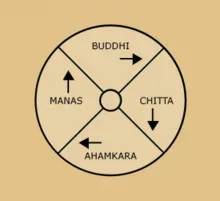Antah karana is a Sanskrit term that refers to the inner tool or instrument of man
Antah Karana: Antah Karana consists of four faculties: buddhi (intellect), ahamkara (ego), manas (thought/counterthought), and chitta (memory). These faculties serve as the medium through which consciousness operates.
It is comprised of four faculties: buddhi (intellect), ahamkara (ego), manas (thought/counterthought), and chitta (memory). According to tantra and yoga, these four principles constitute the medium through which consciousness acts. Antah karana distinguishes human beings from the plant, animal, and mineral kingdoms. In these lower forms of life, antah karana exists in a dormant and tamasic seed state. These creations of nature do not operate from the level of intellect, discrimination, thought, or ego, but from the level of pure instinct.
However, in the case of man, this faculty has gradually evolved to its present capacity. Man has emerged victorious over all other forms of life by the strength of this inner faculty, which has given him the power to reason, think, plan, remember, and enact. The intellectual supremacy of man does not in any way complement the full potential of the antah karana. It is just a mere glimpse of the power that it contains. If the performance of this instrument reaches its full capacity, man cannot only control the inferior creations of nature but also the latent forces within himself, which have the inherent power to create, preserve, and destroy. Thus he would become a co-creator or an instrument, one with nature, replicating her cosmic processes.
Evolution and Function
Antah Karana distinguishes human beings from other forms of life and enables them to reason, think, plan, remember, and act. It evolves from a dormant state in lower forms of life to its present capacity in humans.
Full Potential
the intellectual capacity of humans is only a glimpse of the potential power of Antah Karana. If fully realized, it enables individuals to control both external nature and the latent forces within themselves.
Refinement and Awareness
Refinement of Antah Karana involves tuning it to higher frequencies of pure energy and consciousness. This refinement leads to increased awareness of oneself and the cosmos.
Role in Evolution:
While physical evolution is considered complete, the next stage of evolution pertains to consciousness. The attainment of a ‘superhuman race’ involves the development of higher mental, emotional, rational, and spiritual faculties.
Stages of Mind
The text categorizes the mind into four stages: jagriti (conscious), swapna (subconscious), sushupti (unconscious), and turiya (transcendental). Each stage corresponds to different levels of awareness and experience.
Functions of Buddhi and Ahamkara
Buddhi represents intellect and is associated with discernment and decision-making. Ahamkara represents ego and individuality, influencing one’s perception of identity and separation from the universe.
Manas and Chitta
Manas represents the thinking mind, while chitta represents memory. They are influenced by the three gunas (qualities) and play crucial roles in processing thoughts, experiences, and emotions.
Tattwa Shuddhi
The practice of Tattwa Shuddhi involves purifying and refining the Antah Karana to attain higher states of awareness and consciousness.
Overall, the text emphasizes the importance of understanding and refining the Antah Karana as a pathway to self-realization and spiritual evolution. It underscores the interplay between individual faculties and their impact on human experience and consciousness.
The components of Antah Karana
Buddhi (Intellect)
Buddhi represents the faculty of intellect or higher reasoning. It is associated with discernment, decision-making, and the ability to understand abstract concepts. Buddhi helps individuals analyze situations, make judgments, and contemplate philosophical questions.
Ahamkara (Ego)
Ahamkara refers to the ego or the sense of individual identity. It is the aspect of the psyche that gives rise to the feeling of “I” or self-awareness. Ahamkara contributes to the perception of separation between the self and the external world, leading to a sense of individuality and personal identity.
Manas (Thought/Counterthought)
Manas represents the aspect of the mind responsible for generating thoughts and counterthoughts. It encompasses the stream of consciousness and the constant flow of mental activity, including perceptions, emotions, and internal dialogue.
Chitta (Memory)
Chitta is the faculty associated with memory and the storage of past experiences, impressions, and emotions. It serves as the repository of accumulated knowledge and personal history. Chitta influences perceptions, behaviors, and responses based on past experiences stored within it.
These four components collectively form the inner tool or instrument of human consciousness, known as Antah Karana. They enable individuals to perceive, analyze, interpret, and respond to the world around them, shaping their understanding of reality and their place within it.
The evolution and function of Antah Karana
Evolution from Dormant State
Antah Karana evolves from a dormant and tamasic seed state in lower forms of life, including plants, animals, and minerals. In these lower forms of life, Antah Karana exists in a rudimentary state and operates primarily on instinctual processes rather than intellect, discrimination, thought, or ego.
Gradual Development in Humans
In contrast to lower forms of life, the faculty of Antah Karana has gradually evolved in humans to its present capacity. Through this evolution, humans have acquired the ability to reason, think critically, plan, remember, and enact based on their inner faculties.
Distinguishing Feature of Humanity
Antah Karana distinguishes human beings from other forms of life by providing them with the capacity for intellectual and conscious activity. It enables humans to engage in higher cognitive functions and complex thought processes, setting them apart from lower forms of life.
Victory Over Other Forms of Life: Humans have emerged victorious over other forms of life due to the strength of their Antah Karana. This inner faculty has empowered humans to exercise control over external nature and to manipulate the latent forces within themselves.
Scope of Human Potential
While humans have demonstrated intellectual supremacy over other forms of life, the text suggests that this is only a glimpse of the full potential of Antah Karana. If fully realized, humans could gain control over not only external nature but also the inherent creative, preservative, and destructive forces within themselves.
Exploration by Yogis
Yogis who have attained advanced levels of consciousness have explored the mysteries of Antah Karana. Through dedicated practice and spiritual discipline, they have unlocked the latent potential of their inner faculties and gained mastery over their consciousness.
Overall, the evolution and function of Antah Karana highlight the transformative potential of human consciousness and its role in shaping individual perception, cognition, and behavior. By refining and harnessing the power of Antah Karana, humans can strive towards greater self-awareness, spiritual growth, and realization of their innate capacities.
The concept of the full potential of Antah Karana
Intellectual Supremacy
The intellectual capacity of humans, while significant, is seen as just a glimpse of the power contained within Antah Karana. This suggests that the abilities humans currently possess—reasoning, planning, remembering, and enacting—are only a fraction of what Antah Karana can truly achieve.
Control Over Nature and Self
The full potential of Antah Karana extends beyond intellectual prowess. It includes the ability to control not only external nature but also the latent forces within oneself. This implies mastery over one’s own thoughts, emotions, and actions, as well as the ability to influence and manipulate the external environment.
Co-Creation and Harmony with Nature
Achieving the full potential of Antah Karana enables humans to become co-creators with nature. This suggests a deep level of harmony and alignment with the natural world, where individuals can replicate cosmic processes and participate actively in the unfolding of creation.
Exploration and Mastery
Yogis and spiritual practitioners who have attained advanced levels of consciousness have explored the mysteries of Antah Karana and unlocked its latent potential. Through dedicated practice and inner exploration, they have gained mastery over their consciousness and realized the transformative power within.
Expansion of Awareness
The refinement and tuning of Antah Karana to higher frequencies of pure energy and consciousness lead to an expansion of awareness. This expanded awareness encompasses not only individual experiences but also knowledge of the universe and cosmos as a whole.
Spiritual Evolution
The journey towards realizing the full potential of Antah Karana is part of humanity’s spiritual evolution. It represents a shift from purely intellectual development to a deeper understanding of consciousness, interconnectedness, and the inherent creative forces within oneself and the universe.
In essence, the full potential of Antah Karana signifies a profound awakening to the limitless possibilities of human consciousness and its role in shaping individual destiny, co-creating with nature, and attaining spiritual realization.
Refinement and Awareness
Refinement and awareness of Antah Karana involve a process of inner transformation and self-realization aimed at tapping into the full potential of human consciousness. The text suggests several key points regarding refinement and awareness:
Tuning to Higher Frequencies
Refinement of Antah Karana entails tuning it to higher frequencies of pure energy and consciousness. This process involves elevating one’s awareness beyond the limitations of the mundane world and attuning to subtler levels of existence.
Exploration of Inner Instrument
Individuals engage in practices such as meditation, self-reflection, and spiritual disciplines to explore the mysteries of their inner instrument, the Antah Karana. Through these practices, they aim to unlock the latent potential and hidden depths of consciousness.
Expansion of Consciousness
Refinement of Antah Karana leads to an expansion of consciousness. Individuals become increasingly aware of their inner landscape, including thoughts, emotions, beliefs, and patterns of behavior. This expanded awareness allows for deeper insights into the nature of reality and the self.
Awareness of Cosmic Processes
As individuals refine their Antah Karana, they gain awareness of cosmic processes and universal truths. They recognize their interconnectedness with all of existence and develop a sense of harmony and alignment with the natural world.
Purification and Illumination
Refinement of Antah Karana involves a process of purification and illumination. Individuals strive to purify their minds of negative thoughts, emotions, and conditioning, while cultivating qualities such as compassion, wisdom, and clarity of perception.
Integration of Higher Frequencies
Through the refinement of Antah Karana, individuals integrate higher frequencies of consciousness into their daily lives. They become more attuned to the subtle energies and vibrations that permeate the universe, allowing for greater alignment with their true purpose and potential.
Overall, refinement and awareness of Antah Karana represent a journey of self-discovery and inner transformation. It is a path towards realizing the inherent divinity within oneself and embodying the highest principles of consciousness and enlightenment.
The role of Antah Karana in evolution
Completion of Physical Evolution:
The text suggests that physical evolution in humans is considered complete. This implies that humans have reached a stage where further physical changes are unlikely to occur on a large scale.
Shift to Consciousness Evolution:
While physical evolution may have reached its limit, the next stage of evolution is seen as pertaining to consciousness. This shift implies that the development and refinement of human consciousness become paramount in the evolutionary journey.
Superhuman Race:
The concept of a “superhuman race” is introduced, indicating a state of higher consciousness and evolution beyond the current human condition. This state is characterized by advanced mental, emotional, rational, and spiritual development.
Development of Higher Mind:
The attainment of the superhuman race involves the development of a higher mind, which encompasses mental, emotional, rational, and spiritual faculties at their zenith. This higher mind represents an elevated state of consciousness and awareness.
Teething Stage of Current Faculties:
The text acknowledges that the current faculties of the mind, intellect, and ego are still in their teething stage. This suggests that humans are still grappling with the complexities of their own consciousness and the evolution of their inner faculties.
Purification and Unification of Functions:
Much of the success in evolution depends on the ability to purify, illumine, and unify the functions of Antah Karana. This process involves refining the inner instrument to align with higher frequencies of pure energy and consciousness.
Integration with Cosmic Plan:
Humans are considered integral parts of the cosmic plan, with each individual having a role to play in the grand scheme of creation. The refinement of Antah Karana is seen as vital in understanding and fulfilling one’s role within the cosmic order.
In summary, the role of Antah Karana in evolution underscores the importance of consciousness development and the realization of higher states of awareness. It represents a shift from physical evolution to the evolution of consciousness, leading towards the attainment of a superhuman state characterized by advanced mental, emotional, rational, and spiritual faculties.
Stages of Mind:
The stages of mind
Jagriti (Conscious State): Jagriti represents the conscious state of mind. In this stage, individuals are fully awake and aware of their surroundings. The conscious mind processes sensory information, engages in logical reasoning, and interacts with the external world.
Swapna (Subconscious State)
Swapna denotes the subconscious state of mind, which is experienced during dreaming. In this stage, the mind is active, but the individual is not fully conscious of their external environment. The subconscious mind processes symbolic imagery, emotions, and memories, often in a fragmented or distorted manner.
Sushupti (Unconscious State)
Sushupti refers to the unconscious state of mind, which occurs during deep sleep. In this stage, the conscious mind is inactive, and individuals experience a state of profound relaxation and rest. The unconscious mind may still be active, processing deep-seated emotions, desires, and subconscious patterns.
Turiya (Transcendental State)
Turiya represents the transcendental state of mind, which transcends the three conventional states of waking, dreaming, and deep sleep. In this stage, individuals experience a state of pure awareness and consciousness beyond the fluctuations of the ordinary mind. Turiya is associated with states of meditation, spiritual awakening, and enlightenment.
These four stages of mind provide a framework for understanding the different states of consciousness experienced by individuals. While the conscious state (Jagriti) is characterized by wakefulness and engagement with the external world, the subconscious (Swapna) and unconscious (Sushupti) states involve deeper levels of mental activity and processing. The transcendental state (Turiya) represents the pinnacle of consciousness, where individuals experience a profound sense of unity, clarity, and inner peace.
Functions of Buddhi and Ahamkara
The functions of Buddhi (intellect) and Ahamkara (ego) play crucial roles in shaping human cognition, behavior, and perception. Here’s an overview of their functions as described in the text:
Buddhi (Intellect)
Discernment and Decision-making: Buddhi is associated with discernment, discrimination, and the ability to make decisions based on rational analysis and understanding.
Judgment and Evaluation: Buddhi enables individuals to evaluate situations, weigh options, and make informed judgments about the best course of action.
Intellectual Capacity
Buddhi represents the higher intellectual faculty of the mind and is responsible for logical reasoning, critical thinking, and problem-solving.
Wisdom and Clarity
In its refined state, Buddhi embodies wisdom, clarity of perception, and the ability to see beyond surface appearances to discern deeper truths.
Role in Spiritual Growth
Buddhi plays a significant role in spiritual growth by guiding individuals towards higher understanding, self-awareness, and realization of their true nature.
Ahamkara (Ego)
Sense of Individual Identity
Ahamkara is the sense of individual identity or “I-consciousness” that distinguishes each person from others.
Attachment and Identification
Ahamkara leads to attachment and identification with one’s thoughts, emotions, experiences, and possessions, creating a sense of separateness from others and the world.
Role in Perception
Ahamkara influences how individuals perceive themselves and their relationships with others, shaping their attitudes, beliefs, and behaviors.
Source of Individuality
Ahamkara forms the nucleus of individual existence, contributing to the formation of personality traits, preferences, and tendencies.
Obstacle to Spiritual Growth
While Ahamkara is essential for navigating the physical world and developing a sense of self, it can also be an obstacle to spiritual growth when it leads to ego-centricity, attachment, and illusion of separateness.
In summary, Buddhi and Ahamkara are integral aspects of the human psyche, each serving distinct functions in cognition, perception, and identity formation. While Buddhi facilitates discernment, rationality, and wisdom, Ahamkara fosters individuality, attachment, and self-awareness. Balancing and harmonizing these faculties are essential for personal growth, self-realization, and spiritual evolution.
Manas and Chitta
Manas and Chitta are essential components of the mind in Indian philosophy, each serving distinct functions in cognition, perception, and memory.
Manas (Thought/Counterthought)
Generation of Thoughts: Manas is the aspect of the mind responsible for generating thoughts, ideas, and mental activities. It encompasses the stream of consciousness and the constant flow of mental processes.
Duality of Thought: Manas operates in a dualistic manner, producing both thoughts and counter-thoughts. It engages in continuous mental activity, including perception, reflection, and decision-making.
Rajasic Tendency: Manas is characterized by a rajasic tendency, which makes it forever distracted and diversified. It tends to jump from one thought to another, akin to a child’s attention moving from one toy to the next.
Influence of the Three Gunas: Manas is influenced by the three gunas or qualities of nature—sattwa, rajas, and tamas. Its activity varies depending on the predominant guna at any given time, leading to fluctuations in mental states and experiences.
Chitta (Memory)
Seat of Experiences: Chitta serves as the seat of all experiences stored in the form of samskaras, archetypes, and memories. It retains impressions from past experiences, emotions, and perceptions, shaping individual consciousness and behavior.
Storage of Samskaras: Chitta contains the accumulated impressions of past actions, thoughts, and emotions known as samskaras. These latent impressions influence perceptions, attitudes, and responses to present situations.
Dual Nature: Chitta exhibits a dual nature, containing both positive and negative samskaras. It holds the potential for both knowledge and ignorance, passion and dispassion, depending on the quality of impressions stored within it.
Influence of Gunas: Similar to Manas, Chitta is influenced by the three gunas—sattwa, rajas, and tamas. The predominant guna determines the quality of experiences and perceptions stored within Chitta, influencing the individual’s mental and emotional states.
In summary, Manas and Chitta represent complementary aspects of the mind, with Manas focusing on the generation of thoughts and mental activities, while Chitta serves as the repository of past experiences and memories. Together, they play vital roles in shaping individual consciousness, perceptions, and responses to the external world.
Tattwa Shuddhi
Tattwa Shuddhi, also known as Tattva Shuddhi, is a practice in yoga and Tantra aimed at purifying the elements or tattvas within the individual’s body and mind. The word “tattva” refers to fundamental elements or principles, while “shuddhi” means purification or cleansing. Here’s an overview of Tattwa Shuddhi:
Concept of Tattvas
In Tattwa Shuddhi, the human body and mind are believed to be composed of five primary elements or tattvas—earth (prithvi), water (apas), fire (tejas), air (vayu), and ether (akasha). These elements are not only physical but also represent subtle energies and aspects of consciousness.
Purification Process
Tattwa Shuddhi involves a systematic process of purifying these elemental energies within the individual. The purification is not just physical but also mental, emotional, and spiritual.
Techniques and Practices: Tattwa Shuddhi incorporates various techniques and practices to facilitate purification. These may include:
Mantra
Chanting specific mantras associated with each tattva to invoke its pure essence and remove impurities.
Visualization: Using visualization techniques to meditate on the elemental energies and purify them at a subtle level of consciousness.
Breathwork: Utilizing pranayama (breath control) practices to balance and harmonize the elemental energies within the body.
Mudras and Asanas: Incorporating specific hand gestures (mudras) and yoga postures (asanas) to channel and balance the elemental energies.
Inner Alchemy: Tattwa Shuddhi is considered a form of inner alchemy, where the practitioner works with the subtle energies of the body and mind to achieve transformation and spiritual growth. It aims to awaken higher states of consciousness and align the individual with the universal principles of existence.
Benefits
The practice of Tattwa Shuddhi is believed to bring numerous benefits, including physical health, mental clarity, emotional balance, and spiritual awakening. It helps individuals connect with the deeper aspects of their being and experience a sense of inner harmony and wholeness.
Integration with Tantric Practices: Tattwa Shuddhi is often integrated into broader Tantric practices, where it serves as a foundational purification technique for preparing the practitioner’s body and mind for more advanced spiritual practices and rituals.
Overall, Tattwa Shuddhi is a profound practice that offers practitioners a systematic approach to purifying their elemental energies and attaining higher states of consciousness, inner balance, and spiritual realization.




